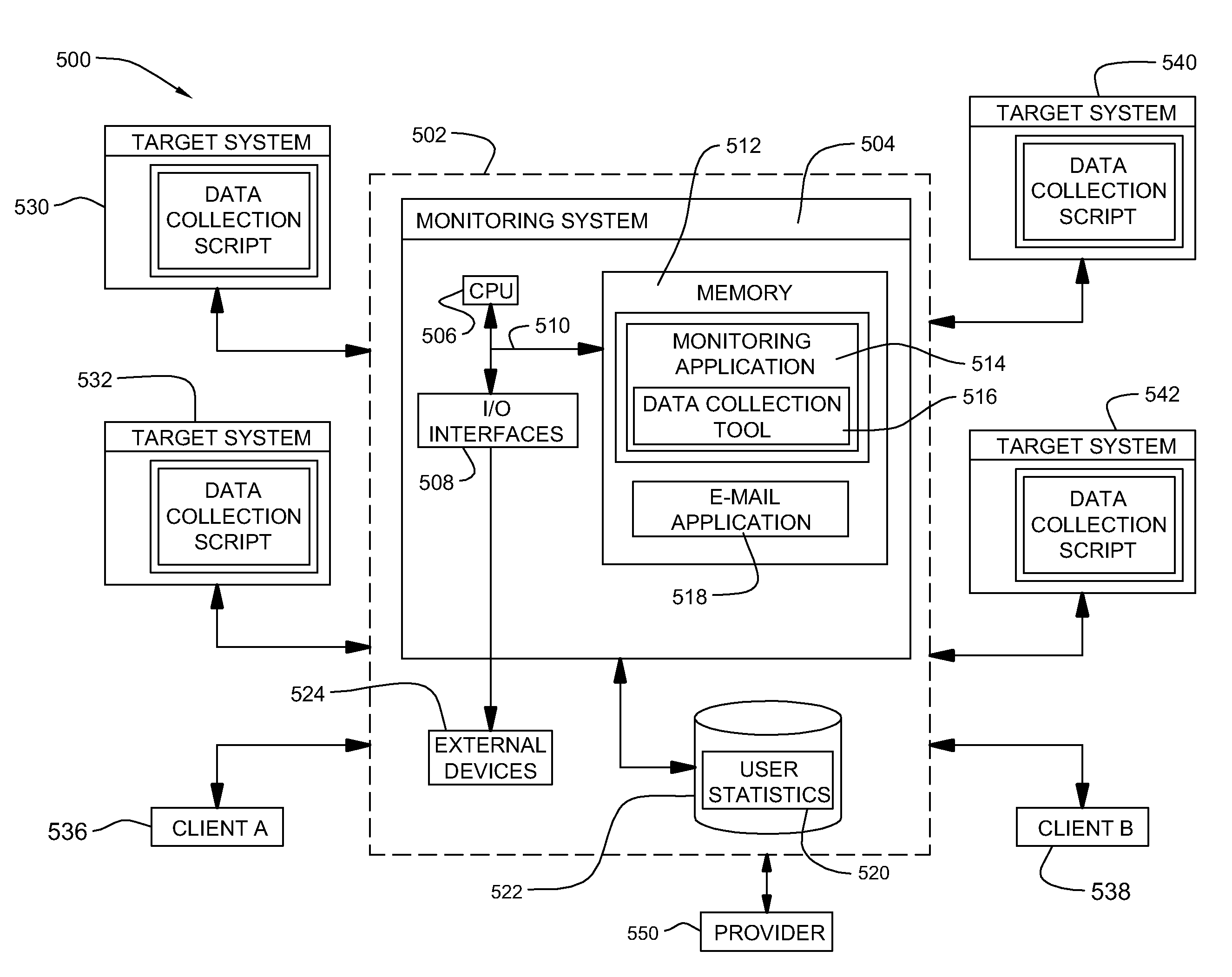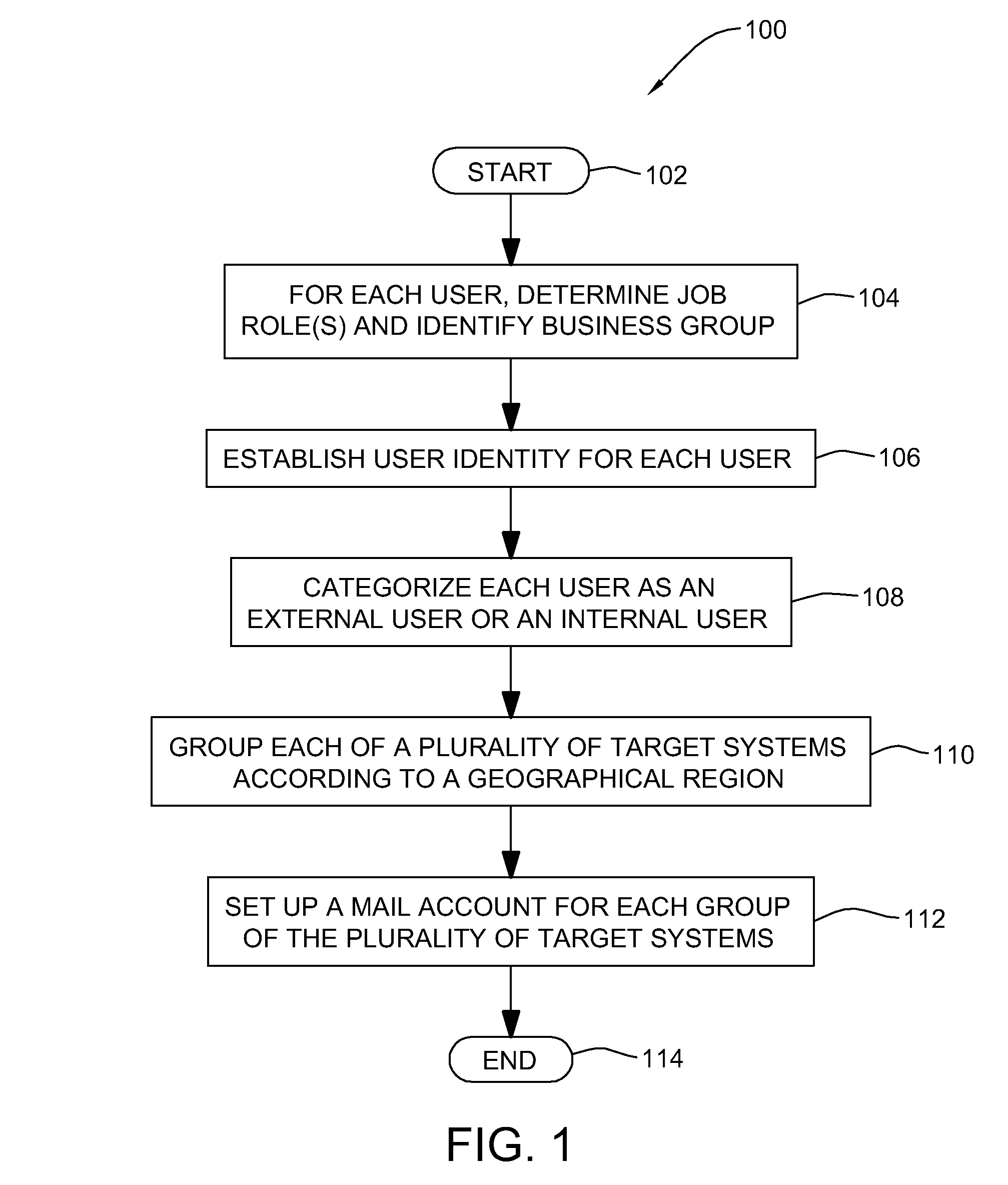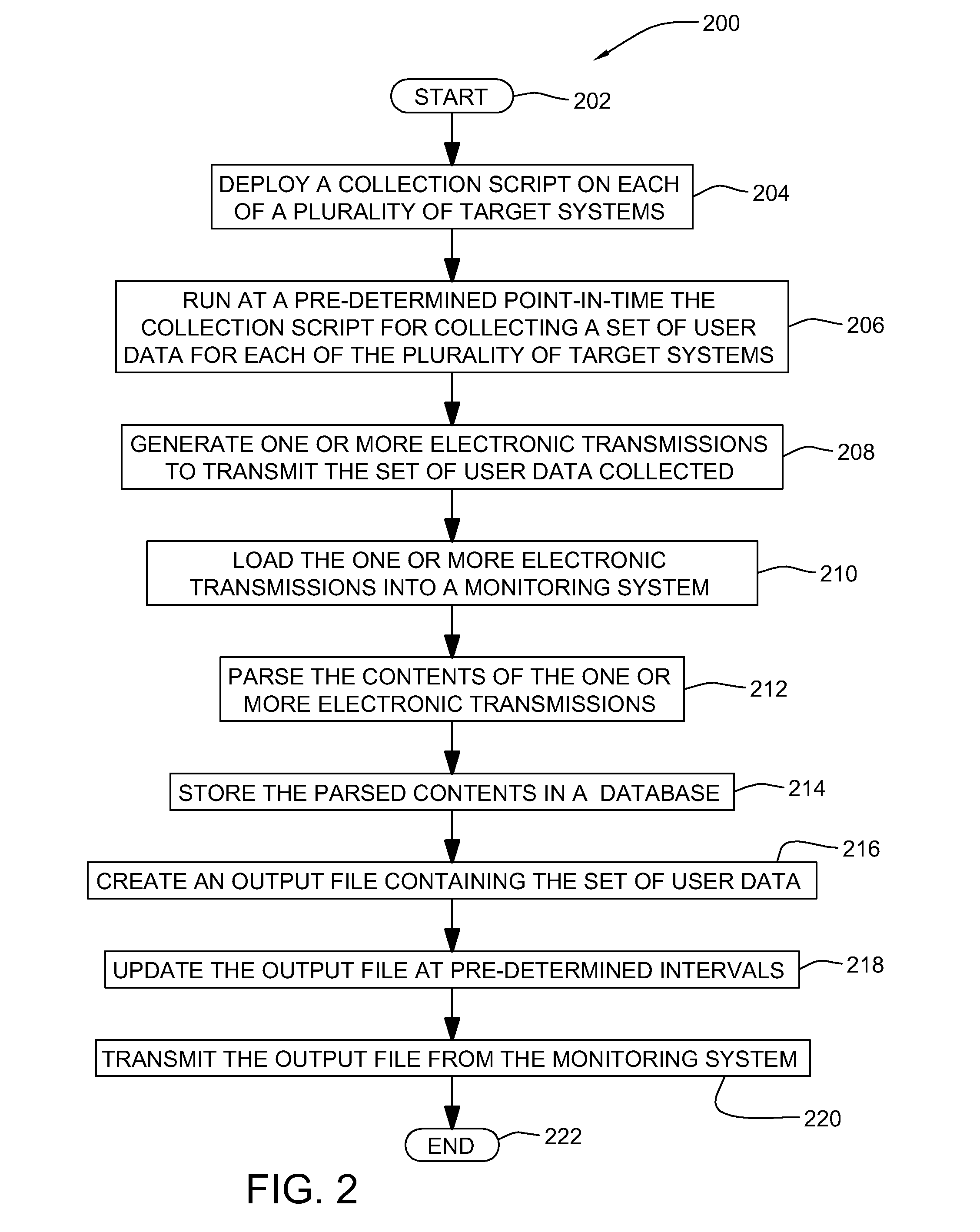[0003]In a first aspect of the invention, there is provided a method for determining a number of users being served by a server. The method comprises running, at a pre-determined point-in-time, a collection script for collecting a set of user data from each of a plurality of target systems, the set of user data collected including a number of concurrent users logged into each of the plurality of target systems at the pre-determined point-in-time. In an embodiment, the running step further comprises deploying the collection script on each of the plurality of target systems. The method further comprises generating one or more electronic transmissions for transmitting the set of user data collected from each of the plurality of target systems, loading the one or more electronic transmissions generated into a monitoring system, and creating an output file containing the set of user data. In an embodiment, the loading step further comprises parsing the set of user data loaded from the one or more electronic transmissions, storing the set of user data collected and parsed into a database and updating, at predetermined intervals, the set of user data stored. Moreover, the method further comprises transmitting the output file from the monitoring system to one or more monitoring system clients. In an embodiment, the method further comprises establishing a user identity for each user seeking access to each of the plurality of target systems, the user identity for each user being associated with one or more job roles and being associated with a business group of the one or more business groups, categorizing each user as either an external user or an internal user, and setting up a mail account for each of the plurality of target systems, wherein each of the plurality of target systems are grouped into one or more geographical regions. In an embodiment, the generating step further comprises producing a count of the number of concurrent users for each of the one or more business units, counting separately any user having an unknown job role, and providing a count of any external users. In an embodiment, the set of user data collected for each of the plurality of target systems comprises at least one of: total number of users daily, total number of users hourly, average number of users daily, total number of users in each of the plurality of regions daily, total number of users in each of the plurality of regions hourly, average number of users daily in each of the plurality of regions, time of login by a user, business group to which a user belongs and time of logout by a user. In an embodiment, the one or more electronic transmissions comprise at least one of: e-mails and FTP files and the output file created comprises an XML file that is configured to interface with the one or more monitoring system clients.
[0004]In another aspect of the invention, there is provided a system for predicting user load for a server at a pre-determined point-in-time. The system comprises a collection script configured to run, at a pre-determined point-in-time, on each of a plurality of servers, the collection script being configured to gather user statistics, including a number of concurrent users accessing each of the plurality of servers at the pre-determined point-in-time, a mail script configured to generate one or more electronic transmissions containing the user statistics gathered, and a utility script configured to load the one or more electronic transmissions generated into a data collection tool, the data collection tool being configured to create an output file containing the user statistics for predicting the user load for each of the plurality of servers at the pre-determined point-in-time. In an embodiment, the utility script is further configured to parse contents of the one or more electronic transmissions loaded, to store the contents parsed into a database and to update, at predetermined intervals, the user statistics stored. In an embodiment, the data collection tool is further configured to interface with one or more monitoring system clients. In an embodiment, the data collection tool is further configured to establish a user identity for each user for accessing any of the plurality of servers, the user identity being associated with one or more job roles and being associated with a business group of the one or more business groups, whereas the data collection tool is further configured to categorize each user as either an external user or an internal user, and wherein the data collection tool is further configured to set up a mail account for each of the plurality of servers, each of the plurality of servers being grouped into one or more regions. In an embodiment, the one or more electronic transmissions comprise at least one of: e-mails and FTP files and the output file created comprises an XML file that is configured to interface with the one or more monitoring system clients. In an embodiment, the user statistics gathered for each of the plurality of servers comprises at least one of: total number of users daily, total number of users hourly, average number of users daily, total number of users in each of the plurality of regions daily, total number of users in each of the plurality of regions hourly, average number of users daily in each of the plurality of regions, time of login by a user, business group to which a user belongs and time of logout by a user.
[0005]In yet another aspect of the invention, there is provided a computer program product for determining a number of concurrent users accessing a target system. The computer program product includes a computer readable medium, first program instructions to collect, at established times, a set of user data from a plurality of target systems, the set of user data including a number of concurrent users accessing each of the plurality of target systems at the established times. The computer program product further includes second program instructions to generate one or more electronic transmissions containing the set of user data collected. The computer program product also includes third program instructions to load the one or more electronic transmissions generated into a data collection tool, the data collection tool being configured to create an output file containing the set of user data for determining the number of concurrent users accessing a target system of the plurality of target systems, and wherein the first, second and third program instructions are stored on the computer readable medium. In an embodiment, the first program instructions include instructions to deploy a collection script for collecting the set of user data on each of the plurality of target systems. Further, in an embodiment, the first program instructions include instructions to establish a user identity for each user seeking access to each of the plurality of target systems, the user identity for each user being associated with one or more job roles and being associated with a business group of the one or more business groups, and instructions to categorize each user as either an external user or an internal user. The first program instructions include instructions to set up a mail account for each of the plurality of target systems, where each of the plurality of target systems is grouped into one or more geographical regions. In an embodiment, the second program instructions include instructions to produce a count of the number of concurrent users for each of the one or more business units, to count separately any user having an unknown job role, and to provide a count of any external users. Further, in an embodiment, the third program instructions include instructions to parse contents of the one or more electronic transmissions loaded, to store the contents parsed into a database and to update, at predetermined intervals, the set of user data stored. In an embodiment, the set of user data collected for each of the plurality of target systems comprises at least one of total number of users daily, total number of users hourly, average number of users daily, total number of users in each of the plurality of regions daily, total number of users in each of the plurality of regions hourly, average number of users daily in each of the plurality of regions, time of login by a user, business group to which a user belongs and time of logout by a user, and wherein the one or more electronic transmissions comprise at least one of: e-mails and FTP files and the output file created comprises an XML file that is configured to interface with the one or more monitoring system clients. Preferably, each of the first, second, third and fourth program instructions are stored on the computer readable medium.
[0006]Further, in yet another aspect of the invention, there is provided a process for deploying computing infrastructure that includes integrating computer-readable code into a computing system, wherein the code in combination with the computing system is capable of performing a process for monitoring user load for a target system at a pre-determined point-in-time. The process comprises establishing a user identity for each user seeking access to each of a plurality of target systems, the user identity for each user being associated with one or more job roles and being associated with a business group of the one or more business groups, categorizing each user as either an external user or an internal user, and setting up a mail account for each of the plurality of target systems, wherein each of the plurality of target systems is grouped into one or more geographical regions. The process further comprises running, at a pre-determined point-in-time, a collection script for collecting a set of user data from each of the plurality of target systems for monitoring said user load, the set of user data collected including a number of concurrent users logged into each of the plurality of target systems at the pre-determined point-in-time, generating one or more electronic transmissions for transmitting the set of user data collected from each of the plurality of target systems, and loading the one or more electronic transmissions generated into a monitoring system. In an embodiment, the running step further comprises deploying the collection script on each of the plurality of target systems. In an embodiment, the generating step further comprises producing a count of the number of concurrent users for each of the one or more business units, counting separately any user having an unknown job role, and providing a count of any external users. In an embodiment, the loading step further comprises parsing the set of user data loaded from the one or more electronic transmissions, storing the set of user data collected and parsed into a database, and updating, at predetermined intervals, the set of user data stored. Moreover, the process comprises creating an output file containing the set of user data, and transmitting the output file created from the monitoring system to one or more monitoring system clients. In an embodiment, the one or more electronic transmissions comprise at least one of: e-mails and FTP files and the output file created comprises an XML file that is configured to interface with the one or more monitoring system clients. Further, in an embodiment, the set of user data collected for each of the plurality of target systems comprises at least one of: total number of users daily, total number of users hourly, average number of users daily, total number of users in each of the plurality of regions daily, total number of users in each of the plurality of regions hourly, average number of users daily in each of the plurality of regions, time of login by a user, business group to which a user belongs and time of logout by a user.
 Login to View More
Login to View More  Login to View More
Login to View More 


